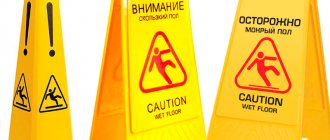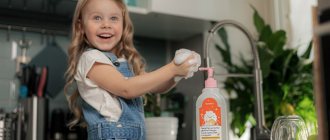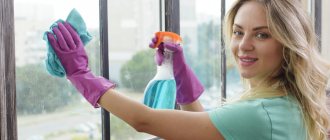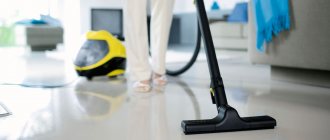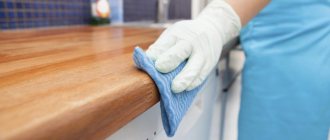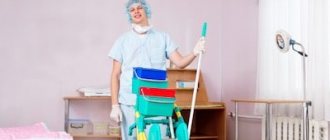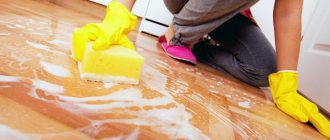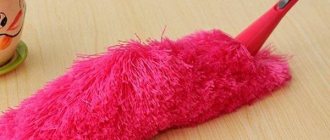The main stages of general house cleaning:
1. Determining the scale of cleaning - indicating the scope of work and the time that is available, the resources involved and the main points. You need to immediately determine whether you plan to completely clean the entire house and every corner in it, or clean one or two rooms. Decide how much time you are willing to spend - one or several days or a couple of hours.
It is also worth thinking about who and how can be involved in performing certain tasks. It’s not at all necessary to clean the toys in the nursery or the husband’s workshop, but you definitely shouldn’t delegate cleaning the kitchen or bedroom to one of the family members.
Further actions and the procedure for cleaning the house will depend on the key points.
2. Drawing up a general plan - indicating the premises, areas that are planned to be cleaned, determining the approximate time for each type of work, and distributing who is responsible for their implementation. The more carefully everything is planned, the faster and more efficient the general cleaning will be.
3. Creating a detailed list of everything needed to implement your plan - prepare detergents, chemicals, tools, bags, storage boxes. It may even make sense to buy a new cabinet or something else necessary.
4. Mental preparation - make tea, rest for about 15 minutes, collect your thoughts and get to work.
5. Implementation of planned tasks - carry out cleaning clearly according to the list, doing everything efficiently and spending a minimum of time. If you discover something unexpected during your hike (the need to sort through all your clothes, the desire to change all the containers for bulk products in the kitchen, or redo something) - do not react, but continue cleaning so as not to get stuck on unplanned tasks.
First you need to clean, and then you will deal with design, rearranging furniture and everything else.
6. Completing additional tasks - what they forgot to write on the list, what was unexpectedly added and what cannot wait until tomorrow (if something spilled or broke somewhere, requires urgent action).
7. Completion of cleaning - airing all rooms, taking a shower and a pleasant evening with a book or movie.
Frequency
Previously, it was necessary to establish thorough order for each significant Orthodox holiday. Nowadays, the first general cleaning of the year is usually timed to coincide with Easter, and the second in the fall during Indian Summer.
If there are animals in the house, or someone is allergic to household dust, then, of course, the usual wet cleaning is repeated several times a week.
Doctors advise carrying out large-scale cleaning called general cleaning once every 3 months or six months.
General cleaning is an event after which you can breathe easier, creating comfort, coziness and safety for all family members.
Some useful tips for general cleaning of your home:
What you need for cleaning: broom, dustpan, vacuum cleaner, mop, brushes of varying degrees of hardness, bristle length, rags or sponges for removing dust, bucket for water, paper towels, wet wipes, wipes for equipment, rubber gloves, brush, detergents ( gels, powders, pastes, sprays) for glass, mirrors, plumbing fixtures, toilets, stoves, furniture.
The order of cleaning involves moving from “clean” rooms to “dirty” rooms - it’s better to start with the nursery, bedroom, living room, and end with the kitchen, bathroom, pantry. Although, there is another method - start cleaning from the furthest room, regardless of its purpose.
Cleaning any room begins with washing the windows, removing the curtains, and cleaning the cornices. Then they move in a top-down direction from the far corner to the door. The final stage should be washing the floors and airing.
First aid for poisoning
Medical personnel working with disinfectants must know the first signs of poisoning in order to provide the necessary assistance:
- Respiratory irritation.
- Sneezing.
- Sore throat.
- Tearing.
- Irritation of skin and mucous membranes.
What to do:
- If the solution gets on your skin, keep the area under running water for 10 minutes. Then lubricate with cream.
- If the solution gets on the eye mucosa, rinse immediately with clean water for 15 minutes and consult an ophthalmologist. There is a high risk of corneal burns.
- If the solution gets into the oral cavity, there is a risk of burns. Rinse your mouth with running water and take 10-15 Activated Carbon tablets. Drink plenty of water. There is no need to induce vomiting.
- If the respiratory system is irritated, remove the victim to fresh air. Rinse your mouth and nose with clean water. You need to drink warm milk.
- After providing emergency assistance, if necessary, the victim can consult a doctor.
Algorithm for cleaning a bedroom, living room, nursery, office:
1. Remove the curtains, put them in the wash, wash the windows and cornices, and wipe off the dust on the windowsill.
2. Remove the upper tiers - remove the cobwebs from the ceilings and corners, wash the chandelier, wipe off the dust on the upper shelves and cabinets (after putting everything in its place).
3. Cleaning the middle tier - take apart all the things, hide the unnecessary ones, carefully fold the rest. Place the garbage in a bag and take it out of the room. Wipe down interior shelves, furniture fronts, handles, doors.
4. Take care of plants, clean surfaces and wipe the screens of equipment and gadgets.
5. Handle upholstered furniture - remove bedspreads and covers from the bed, vacuum everything carefully. Pillows that can be removed, taken out into the yard, knocked out.
6. Floors - vacuum soft surfaces, wash laminate, linoleum, etc. Wipe down the baseboards.
7. Open the window for ventilation.
Checking inventory availability
Before drawing up a DIY cleaning plan, determine what equipment you need for the job and check if everything is available. This will allow you not to be distracted during the process by going to the store or looking for an alternative. Make a list of what you need in advance and check its availability, making the necessary purchases if necessary.
What you may need:
- garbage bags;
- rags, sponges and paper napkins, newspapers for washing glass and mirrors;
- household rubber gloves and apron;
- dishwashing detergent, laundry soap, soda;
- powder cleaner or specialized chemical cleaning products (stoves, ovens, tiles, bathtubs, toilets, chrome parts, furniture, carpets, etc.)
- basin or bucket;
- mop, broom, floor rag;
- vacuum cleaner;
- beater (for carpets and upholstered furniture);
- washing powder;
- additional means and tools if you have any household or interior items that require an individual approach.
Make sure that the vacuum cleaner is working properly, there is enough detergent and there are enough cloth napkins and rags. Don’t forget about garbage bags, you will need a lot of them, especially if you are cleaning a cottage or apartment after renovation or construction.
Algorithm for cleaning the bathroom:
1. Disassemble everything that is piled out of place - put all dirty laundry in the wash or in a basket, hang towels on hooks or put towels on shelves, collect trash and anything that interferes with moving around the bathroom.
2. Remove the upper tier - wipe the shades or lamps, remove cobwebs, you can vacuum the corners.
3. Pay attention to the middle tier - wash the bathroom curtain or the upper parts of the cabin, clean up all the cabinets and shelves: take out all the vials and bottles, wipe the shelves, sort what you need, throw away what you don’t need, put what’s running out in front and write it down in a list shopping for everything you need to buy to replace it.
4. Wash the wall tiles and mirror.
5. Wash the shower stall, toilet, sink, bathtub. Clean and be sure to disinfect plumbing fixtures and faucets.
6. Clean the lower tier in the same way as the middle one - wash everything in the cabinets under the bathtub and sink, sort it, remove garbage, add what is running out to the shopping list.
7. Wash the baseboards and floor, wash or shake out the rugs, and leave the room to dry.
SanPiN requirements
Rules have been approved that implement the therapeutic focus. The most common:
- All medical equipment should be kept clean.
- Routine cleaning of the wards must be carried out at least a couple of times daily using disinfectants.
- The disinfectant should be stored in the manufacturer’s packaging in specially designated areas.
- For the solutions used, separate containers must be allocated, which must have tight-fitting lids. Stickers must be applied to the container with a corresponding inscription describing the solution and the date of preparation.
- When working with disinfectants, observe safety regulations.
- All inventory should be labeled or color coded. The coding scheme is located in the room where the inventory is located.
- When carrying out cleaning, you must make a schedule and strictly adhere to it.
- In maternity rooms, dressing rooms, and treatment rooms, disinfection must be carried out using an antiseptic weekly. On the day of disinfection, surgery is prohibited.
- In order to disinfect the air with an antiseptic, it is necessary to use only approved drugs.
Bacterial filters are allowed.
Algorithm for cleaning the pantry and kitchen:
1. Clean out the pantry: take out everything, throw away what has spoiled, wash the shelves, return the contents back, carefully sorting them and putting them in their places. Wash the floor.
2. Remove the curtains in the kitchen, wash the cornices and windows, glass, window sills.
3. Take care of the upper tier - wash the chandelier, put things in order in all the wall cabinets. Throw away or take into the pantry or garage what you don’t need, wash the shelves, put everything you need in its place: put what is rarely used in the far corners, put everything that is used often closer to the closet door.
4. Pay attention to the middle tier - floor cabinets and under the sink, putting them in order in the same way as wall cabinets. Wash, disinfect, dry the trash can, and put a fresh bag in it.
5. Clean and disinfect countertops, sink, stove.
6. Put household appliances in order - unplug (if necessary), wipe, wash the refrigerator, dishwasher, oven, microwave, electric kettle, mixers, blenders, etc. Put everything in its place.
7. Wash the floor, wipe the baseboards, ventilate.
Afterwards, you can start cleaning the remaining rooms using the same algorithm and “from the far corner to the near” - hallway, balcony, attic, basement, wine cellar, gym, boiler room, laundry room, etc. Only after absolutely all the rooms in the apartment or house have been cleaned can you proceed to cleaning the yard, garage, gazebo and other buildings.
If you still have energy left after a general cleaning of your apartment/house, you can redesign your home. And you don’t have to change absolutely everything! Sometimes it’s enough to place the right accents (a new painting, a change of photo on the mood board, an original bedside table or a beautiful shelf) to make the space completely different.
You can rearrange the furniture or use plants - all this can completely change the appearance of your home and create a spring mood in it.
